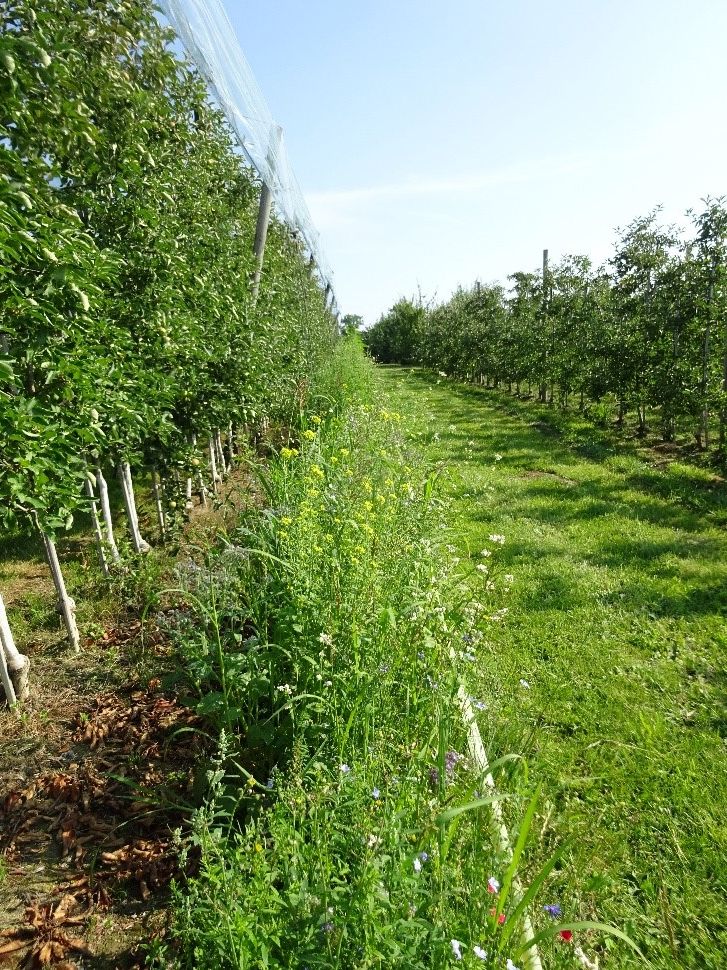Enhancement of pollinator communities in apple orchards
Effects of habitat structures on pollinator communities
in apple orchards in Germany
Team: Prof. Dr. Alexandra-Maria Klein PhD student von Königslöw Project duration: September 2017 - March 2020 Funding: Bayer CropScience |
Collaborators: Dr. Christian Maus and Dr. Juliana Jaramillo, Bayer CropScience, Germany Dr. Lars Lehmberg and Michael Zoth Kompetenzzentrum Obstbau-Bodensee (KOB) |
| Pollinators play an important role for the reproduction of flowering plants (Flyer: "Bienen in Apfelanlagen"). Also many crops depend on bees and other pollinating insects for developing fruits. For example, apple trees depend on pollination for providing high yields. This makes bees important flagship species in the debate about insect decline. In regions with intensive agricultural production, habitats and resources for pollinating insects are often missing. This also applies to intensive apple orchards wich provide a lot of floral resources during apple blossom, but not during the rest of the season. The goal of this project is therefore to test and compare different measures to promote pollinators, especially bees and hover flies. The measures shall provide additional habitat in conventional apple orchards. The project takes place in the Lake Constance region, a hotspot of intensive apple farming in Germany. Thesis: "Effects of semi-natural vegetation structures on pollinators and pollination in IPM-apple orchards" | |
 | Common measures to promote pollinators are for example wildflower strips or nesting aids for cavity-nesting bees. Both measures provide important resources: on the one hand food and on the other hand nesting possibilities. However, wildflower strips persist only temporarily and offer only food, but no nesting resources. Nesting aids are only usable by a minority of bee species. So, both measures provide only limited habitat. Hedge structures have the potential to supply bees and other pollinators long-term with food and nesting resources. Many hedges are though not optimally maintained and so do not realize their full potential. For example, in most hedges an herbaceous fringe is missing, which could offer food after the blossom of the hedge shrubs.
|
| In this project, we test and compare the following measures:
We investigate the abundance and diversity of bees and hover flies in the structures during the entire vegetation period. Furthermore, we analyze possible positive effect on apple cultivation due to increased pollination. | |
 | SFE² GfÖ EEF Joint meeting International Conference on Ecological Sciences 21-25 Nov 2022 Metz (France)
Poster: Session 1 - Hedges and flower strips promote plant-pollinator interactions without compro-mising apple flower visitation
|
Publications
- Mupepele, A.C., von Königslöw, V., Bleile, A.M., Fornoff, F., Fründ, J. & Klein, A.M. (2023): Plant-pollinator interactions in apple orchards from a production and conservation perspective. online first. doi: 10.1101/2023.11.20.567831. Link
- Von Königslöw, V., Fornoff, F. & Klein, A.M. (2022): Wild bee communities benefit from temporal complementarity of hedges and flower strips in apple orchards. Journal of Applied Ecology 59: 2814-2824. Link
- Klein, A.M, von Königslöw, V., Mupepele, A., Fornoff, F. & Wintermantel, D. (2022): Blühstreifen, Hecken und Spontanvegetation: Wie können wir Wildbienen im Obstanbau gezielt fördern? In: Eben, A. & Herz, A. (eds.) Online - Fachgespräch zum Thema „Biodiversität im Obstbau“. Journal für Kulturpflanzen 74 p. 15. Link
- Von Königslöw, V., Fornoff, F. & Klein, A.M. (2022): Pollinator enhancement in agriculture: Comparing sown flower strips, hedges and sown hedge herb layers in apple orchards. Biodiversity and Conservation 31: 433-451. Link
- Von Königslöw, V., Mupepele, A.C. & Klein, A.M. (2021): Overlooked jewels: Existing habitat patches complement sown flower strips to conserve pollinators. Biological Conservation 261: 109263. Link
Press releases
- Semi-natural habitat patches complement flower strips in protecting pollinators
- Bienen Nachrichten: Blühstreifen und Hecken ideal für Wildbienen
